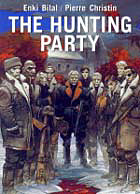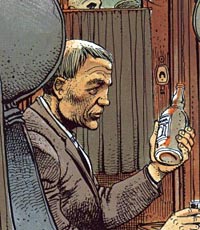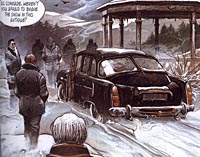>> The Friday Review: Pubo
>> The Friday Review: Get Your War On
More...

 Writer: Pierre Christin
Writer: Pierre Christin
Artist: Enki Bilal
Price: $16.95
Publisher: Humanoids Publishing
ISBN: 0-9672401-7-4
I've spent the last few mornings scraping ice off my car windscreen, so it must be nearly winter again. I find that there's a kind of stark, brutal honesty to winter that's absent from the other seasons. It's dark, and it's cold. Life seems to stop, leaving you feeling alone and exposed. It's a time of hardship, a time to face harsh facts about yourself and the world that you'd really rather ignore.
It's for reasons such as these that I find it particularly appropriate that Enki Bilal and Pierre Christin's THE HUNTING PARTY is set in the winter.
Belgrade-born Enki Bilal is one of Europe's most important comics creators. His career spans four decades and is littered with both critical and commercial successes. First coming to prominence in the seventies, he was peer to the likes of Druillet and Moebius, and certainly as influential. In 1992, his reputation was cemented when he won literary magazine LIRE's prestigious Book of the Year Award for EQUATOR COLD - the first (and so far only) graphic novel to have done so.
Although probably best known for his science fiction epic THE NIKOPOL TRILOGY (of which EQUATOR COLD is the third volume), Bilal also collaborated with writer and journalist Pierre Christin on a number of highly regarded 'political' graphic novels in the late seventies and early eighties, the best of which is generally considered to be PARTIE D'CHASE, or THE HUNTING PARTY.
 Originally published in 1983, the book deals with political intrigues inside the Cold War-era Eastern Bloc. Bilal revisited the work in 1990, adding an epilogue of sorts that dealt with the collapse of the Soviet Union and the consequences it held for the characters in the original story, which has the effect of making the book look both timely and prophetic.
Originally published in 1983, the book deals with political intrigues inside the Cold War-era Eastern Bloc. Bilal revisited the work in 1990, adding an epilogue of sorts that dealt with the collapse of the Soviet Union and the consequences it held for the characters in the original story, which has the effect of making the book look both timely and prophetic.
Set against an empty, frozen landscape somewhere in rural Poland, THE HUNTING PARTY begins as a small party of senior Politburo officials gathers at a country estate for a recreational hunting trip. Foremost among them is Vassily Alexandrovich Chevchenko - a revolutionary hero who has spent a lifetime of service with the likes of the Cheka, the GPU, the NKVD and the KGB. Now suffering from facial paralysis, and as such unable to speak, Chevchenko is nearing the end of his life and has brought together his proteges from around the Eastern Bloc for what may be the last of their annually held social gatherings.
At least, that's what some of the guests are supposed to think. As events unfold before the eyes of Chevchenko's naive young French translator, it gradually becomes clear that this apparently innocent excursion is anything but.
As each guest reminisces about his past association with Chevchenko, the silent, bear-like man emerges as a Charles Foster Kane figure - he is someone who has created dictators, built governments and quite literally shaped the history of the 20th Century. And although he is haunted by the ghostly after-images of his blood-soaked past, he clearly intends to do it again before he dies.
 As such, Chevchenko is a living, breathing refutation of the Communist ideal. The central paradox Chevchenko embodies as a committed Marxist who believes in the malleability of history is clearly intended as a critique of the use and abuse of power in the former Soviet Union. In the 1990 epilogue, Bilal's narrator lays the blame for the 'poisoning' of history squarely at the feet of men like Chevchenko and his companions. The fact that they believe themselves to be acting altruistically in no way excuses their crimes.
As such, Chevchenko is a living, breathing refutation of the Communist ideal. The central paradox Chevchenko embodies as a committed Marxist who believes in the malleability of history is clearly intended as a critique of the use and abuse of power in the former Soviet Union. In the 1990 epilogue, Bilal's narrator lays the blame for the 'poisoning' of history squarely at the feet of men like Chevchenko and his companions. The fact that they believe themselves to be acting altruistically in no way excuses their crimes.
Bilal's characteristically detailed art is perfectly suited to the story. Bilal has always brought a bleak, Eastern European look to the French graphic novel, and as might be expected, nowhere is this more pronounced than here. His intricate crosshatched pen and ink drawings are coloured using watercolours, giving the art a washed-out look that's particularly appropriate, and his weary, naturalistic figures look suitably fragile and vulnerable in the harsh, frozen setting.
Also particularly impressive are the CITIZEN KANE-esque flashbacks used to tell Chevchenko's story - gore-soaked images from the past that litter the narrative like bloody footnotes.
Christin's script, meanwhile, is a typically pacey and robust affair. Christin has an admirable track record for curbing the occasionally self-indulgent tendencies that have hampered many of Bilal's other, solo works. Here, he keeps things particularly tight, with barely a single wasted word or scene.
A cold, efficient and intense thriller, THE HUNTING PARTY sees the actions of one small group of men exposed to the harsh glare of history - and ultimately, history finds them wanting. A study of the corruptive, demoralising effect of power against the backdrop of a wonderfully rendered, bleak and unforgiving winter landscape.
Speaking of which, I must go scrape my car again.

This article is Ideological Freeware. The author grants permission for its reproduction and redistribution by private individuals on condition that the author and source of the article are clearly shown, no charge is made, and the whole article is reproduced intact, including this notice.


